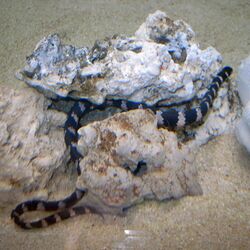Biology:Emydocephalus ijimae
| Emydocephalus ijimae | |
|---|---|

| |
| Scientific classification | |
| Domain: | Eukaryota |
| Kingdom: | Animalia |
| Phylum: | Chordata |
| Class: | Reptilia |
| Order: | Squamata |
| Suborder: | Serpentes |
| Family: | Elapidae |
| Genus: | Emydocephalus |
| Species: | E. ijimae
|
| Binomial name | |
| Emydocephalus ijimae Stejneger, 1898
| |
Emydocephalus ijimae, also called Ijima's sea snake and Ijima's turtleheaded sea snake, is a species of snake in the family Elapidae. The species is endemic to East Asia. E. ijimae feeds exclusively on the eggs of coral reef fishes, which makes them an important predator for maintaining a healthy coral reef ecosystem.[2]
Etymology
The specific name, ijimae, is in honor of Japanese zoologist Isao Ijima (1861–1921).[3]
Geographic range
E. ijimae is found on the coasts of China , Japan (including the Ryukyu Islands), and Taiwan.[1][4]
Sex & Growth
E. ijimae exhibit sexual size dimorphism with males reaching a snout-vent length (SVL) typically less than 750 mm and females sometimes exceeding 800 mm. Females also have a larger body weight ranging from 170 to 600 g compared to the male that weighs in at 70 to 350 g. The female BW also experiences greater fluctuations than males. Adult males typically see an increase in BW from early spring to late summer and females occasionally undergo a rapid BW decrease from late autumn to early spring followed by a steady weight regain.[2]
SVL in newborn E. ilijmae is between 266 mm and 342 mm. Neonate males have been reported to grow 0.27 mm/day while neonate females grow 0.36 mm/day. The snakes reach maturity around the same age. Between 19-28 months for males and 19-26 months for females.[2]
Reproduction
E. ijimae is viviparous.[4] Neonates begin reproductive activity in the second or third summer and third spring after birth. Studies have suggested that E. ijimae are income breeders that rely on temporal energy intake to produce offspring.[2]
References
- ↑ 1.0 1.1 Lukoschek V, Sanders K (2010). "Emydocephalus ijimae". IUCN Red List of Threatened Species 2010. https://www.iucnredlist.org/details/176706/0. Retrieved 13 December 2016.
- ↑ 2.0 2.1 2.2 2.3 Masunaga, Gen; Hidetoshi, Ota (2003). "Growth and Reproduction of the Sea Snake, Emydocephalus ijimae, in the Central Ryukyus, Japan: a Mark and Recapture Study". Zoological Science 20: 461-470. https://bioone.org/journals/Zoological-Science/volume-20/issue-4/zsj.20.461/Growth-and-Reproduction-of-the-Sea-Snake-Emydocephalus-ijimae-in/10.2108/zsj.20.461.full.
- ↑ Beolens, Bo; Watkins, Michael; Grayson, Michael (2011). The Eponym Dictionary of Reptiles. Baltimore: Johns Hopkins University Press. xiii + 296 pp. ISBN:978-1-4214-0135-5. (Emydocephalus ijimae, p. 129).
- ↑ 4.0 4.1 Emydocephalus ijimae at the Reptarium.cz Reptile Database. Accessed 13 December 2016.
Further reading
- Stejneger L (1898). "On a Collection of Batrachians and Reptiles from Formosa and Adjacent Islands". J. College Sci., Imperial Univ. Tokyo 12 (3): 215–225. (Emydocephalus ijimae, new species, p. 223).
- Stejneger L (1907). Herpetology of Japan and Adjacent Territory. United States National Museum Bulletin 58. Washington, District of Columbia: Smithsonian Institution. xx + 577 pp. (Emydocephalus ijimae, pp. 413–417, Figures 334-337).
External links
- Photos of Emydocephalus ijimae on Sealife Collection
Wikidata ☰ Q3010090 entry


